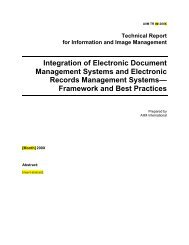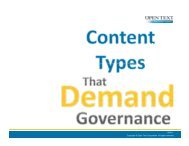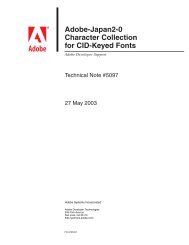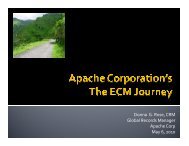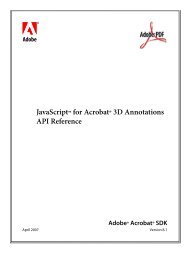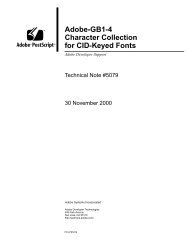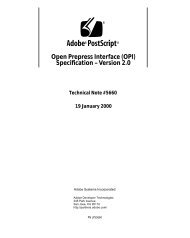Introduction to StratML - AIIM
Introduction to StratML - AIIM
Introduction to StratML - AIIM
Create successful ePaper yourself
Turn your PDF publications into a flip-book with our unique Google optimized e-Paper software.
Standard Recommended Practice -<br />
Strategy Markup Language - Part 1:<br />
<strong>StratML</strong> Core
‣ <strong>StratML</strong> Definition, Focus, Intent & Status<br />
‣ Related eGov Initiatives<br />
‣ <strong>StratML</strong> Tools & Pro<strong>to</strong>type Services<br />
‣ Part 2, Performance Plans & Reports<br />
‣ What <strong>StratML</strong> Can Do for You<br />
‣ Needed Applications & Services<br />
‣ How You Can Help
Strategy Markup Language (<strong>StratML</strong>) Part 1 is an<br />
XML vocabulary and schema for the elements<br />
commonly contained in strategic plans.<br />
<strong>StratML</strong> Part 2 will extend Part 1 <strong>to</strong> include the<br />
additional elements required for performance<br />
plans and reports.<br />
Part 3 and perhaps additional parts will<br />
incorporate additional elements that, while not<br />
deemed essential, may add value <strong>to</strong> the core<br />
elements of strategic and performance plans.
Although the initial focus has been on the<br />
plans U.S. federal agencies are required <strong>to</strong><br />
compile and maintain under the Government<br />
Performance and Results Act (GPRA), the<br />
intent is for <strong>StratML</strong> <strong>to</strong> be adopted as an<br />
international voluntary consensus<br />
standard for potential use by all<br />
organizations worldwide, as well as<br />
individuals who choose <strong>to</strong> lead mission/goaldirected<br />
lives.
Core Elements<br />
1. Organization<br />
2. Mission<br />
3. Vision<br />
4. Value<br />
5. Goal<br />
6. Objective<br />
7. Stakeholder<br />
ANSI/<strong>AIIM</strong> Standard<br />
• Announcement<br />
• Crosspromotion/marketing<br />
Pro<strong>to</strong>types<br />
• Tools & services<br />
• >500 <strong>StratML</strong> docs
• President Obama’s Open Gov Directive<br />
• Open Gov Brains<strong>to</strong>rming<br />
• Data.gov<br />
• eGov Act<br />
• E-FOIA<br />
• OMB Circular A-119<br />
• W3C eGov IG Open Gov Data Working Draft
• What is government doing<br />
• Goals & objectives<br />
• In what form can the public readily find & use information<br />
• HTML, XML, <strong>StratML</strong> with style sheets, applications & intermediary services<br />
• E-FOIA amendments<br />
• Data.gov<br />
• How can the public provide feedback<br />
• <strong>StratML</strong> applications/services<br />
• More mature, social networking focused on stakeholders, goals & objectives
• Public engagement ~ <strong>StratML</strong> applications<br />
• Effectiveness ~ Measurable results, reported <strong>to</strong> stakeholders<br />
• Input <strong>to</strong> improve public participation ~ To what end<br />
• More efficient/effective pursuit of .gov goals & objectives
• What is the “work of government”<br />
• Missions, goals & objectives<br />
• Innovative <strong>to</strong>ols, methods & systems <strong>to</strong> cooperate ~<br />
on What<br />
• Goals & objectives<br />
• How better <strong>to</strong> solicit public feedback<br />
• Mature social networking services by applying <strong>StratML</strong>
<strong>StratML</strong> is an open format
The purposes of the <strong>StratML</strong> standard include facilitating stakeholder<br />
feedback on strategic goals and objectives, e.g., those <strong>to</strong> be documented<br />
in agency open gov plans.<br />
Agency open gov plans should be published in <strong>StratML</strong> format.<br />
Note: M-10-06 is available in <strong>StratML</strong> format with basic styling, including a<br />
hyperlinked table of context at http://xml.gov/stratml/crane/OGD.xml
• Access <strong>to</strong> “high-value” datasets ~ Aligned with strategic goals/objectives<br />
• Machine readable ~ CSV & XML (e.g., <strong>StratML</strong>)<br />
• Catalog ~ by Stakeholder groups, goals & objectives
<strong>StratML</strong> will enable agencies <strong>to</strong> comply with the<br />
provisions of subsections 202(b)(4) & (5) and 207(d) of<br />
the eGov Act, which respectively require agencies <strong>to</strong>:<br />
• Work <strong>to</strong>gether <strong>to</strong> link their performance goals <strong>to</strong> key groups,<br />
including citizens, businesses, and other governments, as<br />
well as internal Federal Government operations; and<br />
• Adopt open standards (e.g., <strong>StratML</strong>) enabling the<br />
organization and categorization of Government information in<br />
a way that is searchable electronically and interoperably<br />
across agencies.<br />
“Key groups” = Stakeholders<br />
<strong>StratML</strong> = Open standard enabling queries interoperably across agencies
… an agency shall provide [records] in any form<br />
or format requested … if the record is readily<br />
reproducible by the agency in that form or format.<br />
Each agency shall make reasonable efforts <strong>to</strong><br />
maintain its records in forms or formats that are<br />
reproducible …<br />
5 USC 55 (a)(3)(B)<br />
XML (<strong>StratML</strong>) is machine readable and readily reproducible<br />
The <strong>StratML</strong> collection already includes the plans of<br />
• All of the cabinet-level agencies (but not the bureaus)<br />
• Most of the smaller agencies (Small Agency Council members)
6. What Is The Policy For Federal Use Of Standards<br />
All federal agencies must use voluntary consensus standards in lieu of<br />
government-unique standards … except where inconsistent with law or<br />
otherwise impractical.<br />
7. What Is The Policy For Participation In Voluntary Consensus<br />
Standards Bodies<br />
Agencies must consult with voluntary consensus standards bodies …<br />
and must participate with such bodies in the development of voluntary<br />
consensus standards when consultation and participation is in the<br />
public interest and is compatible with their missions, authorities,<br />
priorities, and budget resources<br />
<strong>StratML</strong> ~<br />
Is a voluntary consensus standard<br />
Can be used <strong>to</strong> document/share agency missions & goals/objectives<br />
(priorities)<br />
Is not government-unique<br />
<strong>StratML</strong> <strong>to</strong>ols/services can make it very practical <strong>to</strong> use<br />
Participation in standards development bodies should support agency<br />
objectives (as documented in <strong>StratML</strong> format)
Aneesh Chopra, U.S. Chief Technology Officer<br />
… there must be a structured approach <strong>to</strong> open government,<br />
including a schedule for the public release of government data in<br />
machine-readable formats.<br />
… government agencies should engage the public in developing<br />
open government plans and publish their completed plans.<br />
Information Week, September 9, 2009<br />
<strong>StratML</strong> is a structured approach for releasing the data contained in<br />
strategic<br />
and performance plans in machine-readable format .<br />
Eventually, more mature social networking technologies and services<br />
should facilitate engagement and feedback from stakeholders<br />
‣ On the plans of organizations whose missions, goals, and<br />
objectives are of interest <strong>to</strong> them.
• Documentation & Transformation Services – Drybridge Technologies<br />
• CAM Interactive Documentation – David Webber<br />
• Authoring/Editing Tools<br />
• Adobe, Xopus, Business Web Software, XML , Syntext &<br />
IC Tect<br />
• Tag Cloud – Strategi Consulting, Ari Knausenberger<br />
• A<strong>to</strong>m Demonstration – Joe Carmel<br />
• Basic Stylesheet – Crane Softwrights, Ken Holman<br />
• Farsi Translations & <strong>StratML</strong> Transformation Portal – Pooyan Zamanian<br />
• Search Service – Mark Logic, Shashi Mudunuri<br />
• Schema Design – Vision4Standards, Sylvia Webb
During the development, piloting, proof-of-concept phase, more than<br />
500 strategic plans were rendered in <strong>StratML</strong> format, using five<br />
different authoring/conversion <strong>to</strong>ols, including:<br />
• Microsoft InfoPath using this form<br />
• Business Web Software AchieveForms<br />
• Adobe PDF Fillable Form<br />
• Xopus Form (Available in Spanish as well as English)<br />
• Microsoft Word, with assistance from Ictect
<strong>StratML</strong> Quick Start Guide for MS Word Users
See alternate terms in <strong>StratML</strong> Glossary
• Candidate Elements<br />
• Simplified Graphics<br />
• More Detailed Graphics
1) Stakeholder<br />
At least one Stakeholder of the performer type must be identified, although the named<br />
performer may be an organizational role rather than a particular individual.<br />
2) Metric<br />
At least one Objective must be included and a Metric should be associated with it.<br />
3) Outcome<br />
At least one desired Outcome should be specified, because no organization should exist<br />
solely for self-serving purposes.<br />
4) Output<br />
The Outputs required <strong>to</strong> achieve the desired Outcome(s) should be specified.<br />
5) Input<br />
The Inputs required <strong>to</strong> produce Outputs should be specified.<br />
6) Process<br />
The Processes required <strong>to</strong> produce Outputs and Outcomes should be specified.
Performance Plans & Reports: The Value Chain<br />
Inputs Processes Outputs Processes Outcomes
Input<br />
Process<br />
Name Description Metrics<br />
Name Description Metrics<br />
Measurement<br />
Dimension<br />
Number of<br />
Units<br />
Measurement<br />
Frequency<br />
Measurement<br />
Dimension<br />
Number of<br />
Units<br />
Measurement<br />
Frequency<br />
Output<br />
Outcome<br />
Name Description Metrics<br />
Name Description Metrics<br />
Measurement<br />
Dimension<br />
Number of<br />
Units<br />
Measurement<br />
Frequency<br />
Measurement<br />
Dimension<br />
Number of<br />
Units<br />
Measurement<br />
Frequency
Metrics<br />
Measurement<br />
Dimension<br />
Number of<br />
Units<br />
Measurement<br />
Frequency<br />
Unit Type<br />
Number Type<br />
Time Unit<br />
Type<br />
Number of<br />
Units
• Intended Purposes / Needed Applications<br />
• How You Can Help
Facilitate the sharing, referencing, indexing, discovery, linking,<br />
reuse, and analyses of the elements of strategic plans, including<br />
goal and objective statements as well as the names and<br />
descriptions of stakeholder groups and any other content<br />
commonly included in strategic plans.<br />
Enable the concept of "strategic alignment" <strong>to</strong> be realized in<br />
literal linkages among goal and objective statements and all other<br />
records created by organizations in the routine course of their<br />
business processes.<br />
Facilitate the discovery of potential performance partners who<br />
share common goals and objectives and/or either produce inputs<br />
needed or require outputs produced by the organization compiling<br />
the strategic plan.<br />
Facilitate stakeholder feedback on strategic goals and objectives.
Facilitate updating and maintenance of discrete elements of strategic plans without<br />
requiring review and approval of the entire plan through bureaucratic channels,<br />
thereby helping <strong>to</strong> make the strategic planning process more agile and responsive <strong>to</strong><br />
stakeholder feedback and changing circumstances, thus helping <strong>to</strong> overcome the<br />
tendency of strategic plans <strong>to</strong> become outdated "shelfware".<br />
<br />
Reduce the needless time, effort, inconsistencies, and delays associated with<br />
maintaining data redundantly in myriad "s<strong>to</strong>vepipe" systems rather than referencing<br />
the authoritative sources.<br />
<br />
Enable agencies <strong>to</strong> comply with the provisions of subsections 202(b)(4) & (5) and<br />
207(d) of the eGov Act, which respectively require agencies <strong>to</strong>:<br />
• Work <strong>to</strong>gether <strong>to</strong> link their performance goals <strong>to</strong> key groups, including citizens,<br />
businesses, and other governments, as well as internal Federal Government<br />
operations; and<br />
• Adopt open standards (e.g., <strong>StratML</strong>) enabling the organization and<br />
categorization of Government information in a way that is searchable<br />
electronically and interoperably across agencies.
As a manager in an<br />
organization, you will be<br />
able more efficiently and<br />
effectively <strong>to</strong> engage your<br />
employees, partners, and<br />
other stakeholders not<br />
only in crafting but also<br />
carrying out your strategic<br />
goals and objectives.<br />
As an application<br />
developer or service<br />
provider, you will have<br />
the opportunity <strong>to</strong><br />
leverage and extend the<br />
<strong>StratML</strong> <strong>to</strong> demonstrate<br />
your capabilities <strong>to</strong> more<br />
fully support your existing<br />
cus<strong>to</strong>mers as well as <strong>to</strong><br />
attract new cus<strong>to</strong>mers.<br />
Having a standard<br />
vocabulary and schema for<br />
strategic plans will make<br />
it easier <strong>to</strong> develop such<br />
applications and services.
As a citizen and<br />
tax payer, you will<br />
be able <strong>to</strong> more<br />
easily discover,<br />
comment on, and<br />
participate in the<br />
establishment of the<br />
goals and objectives<br />
of agencies whose<br />
missions are of<br />
particular interest<br />
<strong>to</strong> you.<br />
As a volunteer<br />
and/or contribu<strong>to</strong>r<br />
<strong>to</strong> charitable<br />
organizations, you<br />
will be able <strong>to</strong> more<br />
easily discover<br />
those who share<br />
your values and are<br />
pusuing objectives<br />
you consider <strong>to</strong> be<br />
worthy of priority<br />
for your support.
As a cus<strong>to</strong>mer or<br />
inves<strong>to</strong>r, you will<br />
be able <strong>to</strong> review<br />
and provide<br />
feedback far more<br />
efficiently and<br />
effectively on the<br />
goals and objectives<br />
of companies that<br />
are truly cus<strong>to</strong>mer<br />
focused and share<br />
their strategic plans<br />
openly.<br />
To the degree that<br />
Part 2 is<br />
implemented and<br />
used, you will also<br />
be able <strong>to</strong> track and<br />
moni<strong>to</strong>r the<br />
performance of<br />
organizations about<br />
whose goals you<br />
care.
In addition, Part 2 will enable<br />
vendors <strong>to</strong> identify their products<br />
and services as inputs required <strong>to</strong><br />
produce outputs desired by<br />
cus<strong>to</strong>mers in order <strong>to</strong> achieve their<br />
objectives. At the same time,<br />
consumers will be able <strong>to</strong> identify<br />
the qualities of such products and<br />
services they deem <strong>to</strong> be<br />
important. The effect will be <strong>to</strong><br />
revolutionize the advertising and<br />
marketing paradigm, putting<br />
consumers in control and vastly<br />
reducing the needless time, effort,<br />
and cost of bringing suppliers and<br />
consumers <strong>to</strong>gether in the<br />
marketplace.<br />
<br />
Finally, as an individual who<br />
chooses <strong>to</strong> lead a mission/goaldirected<br />
life, you will be able far<br />
more efficiently and effectively <strong>to</strong><br />
engage those who share your<br />
values in the pursuit of<br />
objectives you hold in common.<br />
In that respect, the current social<br />
networking technologies are a<br />
mere shadow of what such services<br />
can become when they implement<br />
the <strong>StratML</strong> standard and begin <strong>to</strong><br />
enable focus on the<br />
accomplishment of objectives<br />
(achievement of results rather than<br />
merely what we look like, whom<br />
we know, or what we happen <strong>to</strong> be<br />
doing at the moment.
Foster awareness of the <strong>StratML</strong> standard<br />
Help specify Parts 2 & 3<br />
Encourage organizations <strong>to</strong> maintain their plans in<br />
<strong>StratML</strong><br />
Convert some plans yourself<br />
Encourage social networking sites <strong>to</strong> use <strong>StratML</strong><br />
Develop <strong>StratML</strong> applications and services
Owen.Ambur@verizon.net<br />
http://xml.gov/stratml/index.htm



